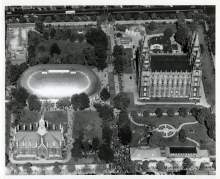This is an archived article that was published on sltrib.com in 2017, and information in the article may be outdated. It is provided only for personal research purposes and may not be reprinted.
Editor's note • Every Saturday, Salt Lake Tribune columnist Robert Kirby digs into the state's past to enlighten or, at least, entertain Utahns in the present. Have a story to share? Visit Facebook.com/DisturbingHistory or email rkirby@sltrib.com.
My first experience with Salt Lake City's famed Temple Square was in 1971, when several friends and I were "asked" to leave the grounds by LDS security officials.
Our inappropriate language/behavior eventually attracted the attention of two very cordial guards. Politeness aside, they still meant business in asking us to go. It was the first time I'd ever heard the word "please" sound like "while your head is still somewhat round."
My next visit to Temple Square occurred two years later, when I left on a Mormon mission. I walked back through the same gate I'd previously been thrown out.
Now, whenever I find myself on Temple Square, I'm invariably reminded of the contrast between those events. I like it. There's a lot of truth in irony.
A couple of weeks ago, I was on the square again when church representatives caught up with me again. I was looking up at Angel Moroni on top of the temple as two young women with name tags crept in behind me. French and Mexican, they introduced themselves and offered to explain the significance of the golden statue.
They switched off their target lock when I explained that I was already Mormon. We stood and looked up at Angel Moroni together.
Sister F: "I think he's a great sign to the world."
Me: "I think it's amazing that his trumpet is still attached to his face."
In April 1910, Moroni's trumpet was knocked awry by a bomb set at the construction site of the Hotel Utah across the street. The bomb, which involved a labor dispute, shattered windows blocks away.
Moroni's trumpet wasn't fixed until two months later, when the church paid a couple of steeplejacks $125 to climb the spire and reposition it.
I told them that, in November 1962, the southeast doors of the temple had been bombed, blowing off a doorknob and shattering glass.
Even that wasn't the last time Temple Square was hit with a bomb. On April 6, 1963, someone detonated a coffee can filled with phosphorus against the north wall of the LDS museum. Nobody, including Moroni, got hurt.
I don't think they believed me much about the bombs. But they perked right up when I mentioned that two guys were arrested in 1974 for "streaking" right past where we were standing.
Sister M: "Es-treaking?"
Me: "Yeah. Running around stark naked."
That was apparently enough. The sisters thanked me for my interest in the LDS Church and went off to find someone else.
I'm hardly the only one who's ever been "escorted" off Temple Square. All sorts of people have that distinction, and for reasons much worse than being high.
In January 1938, four men attempted to set fire to the Tabernacle. The building was occupied by 3,000 people when self-styled prophet George Otis sprayed a protective circle of flaming gasoline and attempted to address everyone while his club-wielding followers held bystanders at bay.
A church custodian happened along, jumped over the fire, snatched Otis sideways, and turned him over to police. Otis spent the rest of his life in the state hospital.
On Oct. 10, 1952, presidential candidate Dwight D. Eisenhower spoke to a cheering crowd in the LDS Salt Lake Tabernacle. Four days later, Eisenhower's main opponent, Adlai E. Stevenson, got his turn. He lashed out at Eisenhower and Congress, calling them "assassins." It marked the first time an event in Utah was televised coast to coast.
There's more about Temple Square that visitors never hear about. In May 1923, Sir Arthur Conan Doyle, author of the Sherlock Holmes mystery series, addressed a crowd of 5,000 in the Tabernacle on the subject of psychic spiritualism.
On Jan. 5, 1890, while Mormon authority B.H. Roberts was speaking, A.J. Moller, being of unsound mind, entered the Tabernacle dressed in a floor-length robe and tunic of white satin. Bearing a long staff, he strolled silently around until ushers escorted him out and turned him over to the police.
Maybe it's me. Everything is a lot more interesting with irony.



